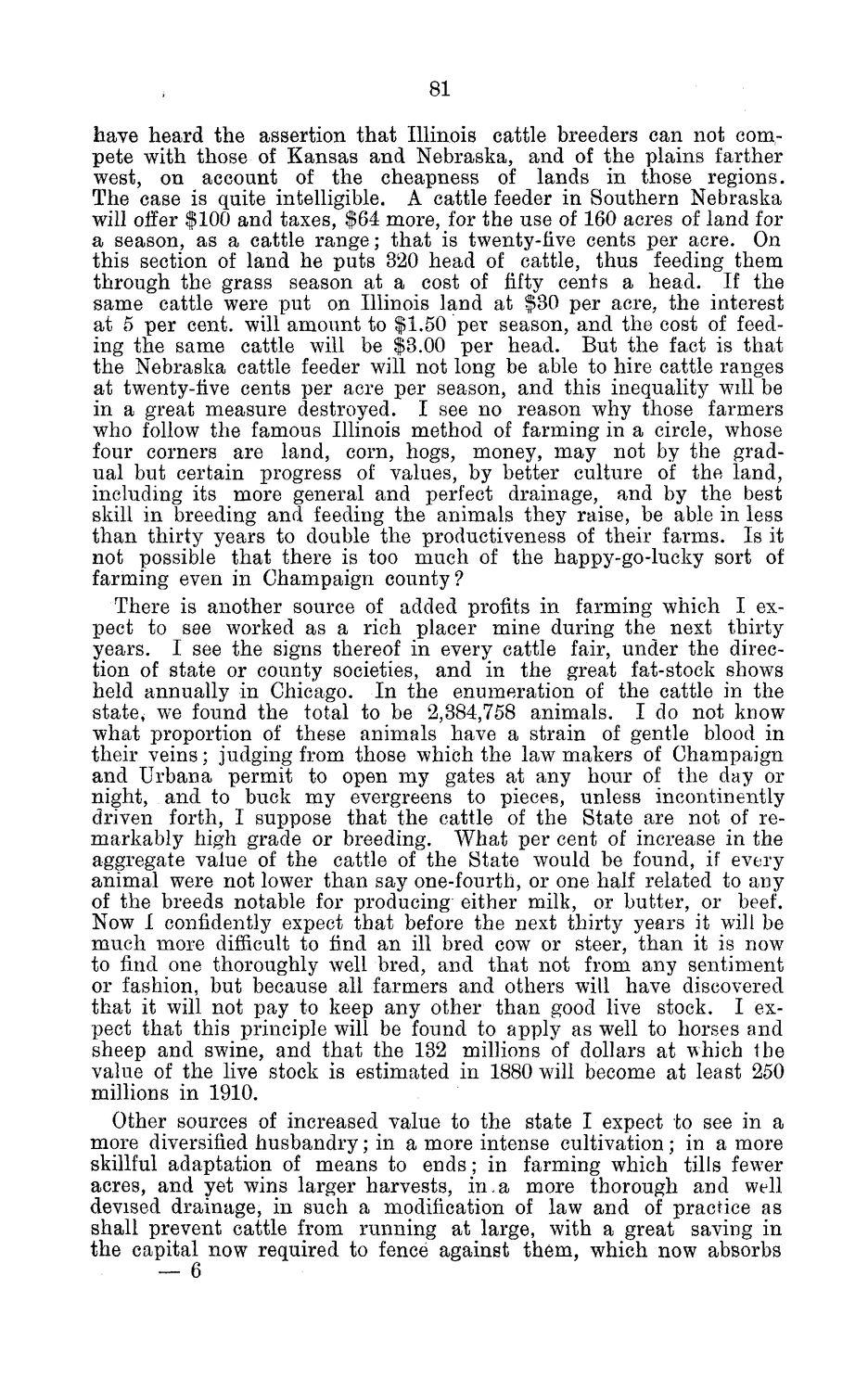| |
| |
Caption: Board of Trustees Minutes - 1884
This is a reduced-resolution page image for fast online browsing.

EXTRACTED TEXT FROM PAGE:
81 have heard the assertion that Illinois cattle breeders can not compete with those of Kansas and Nebraska, and of the plains farther west, on account of the cheapness of lands in those regions. The case is quite intelligible. A cattle feeder in Southern Nebraska will offer $ 100 and taxes, $64 more, for the use of 160 acres of land for a season, as a cattle range; that is twenty-five cents per acre. On this section of land he puts 320 head of cattle, thus feeding them through the grass season at a cost of fifty cents a head. If the same cattle were put on Illinois land at $30 per acre, the interest at 5 per cent, will amount to $1.50 per season, and the cost of feeding the same cattle will be $3.00 per head. But the fact is that the Nebraska cattle feeder will not long be able to hire cattle ranges at twenty-five cents per acre per season, and this inequality will be in a great measure destroyed. I see no reason why those farmers who follow the famous Illinois method of farming in a circle, whose four corners are land, corn, hogs, money, may not by the gradual but certain progress of values, by better culture of the land, including its more general and perfect drainage, and by the best skill in breeding and feeding the animals they raise, be able in less than thirty years to double the productiveness of their farms. Is it not possible that there is too much of the happy-go-lucky sort of farming even in Champaign county? There is another source of added profits in farming which I expect to see worked as a rich placer mine during the next thirty years. I see the signs thereof in every cattle fair, under the direction of state or county societies, and in the great fat-stock shows held annually in Chicago. In the enumeration of the cattle in the state, we found the total to be 2,384,758 animals. I do not know what proportion of these animals have a strain of gentle blood in their veins; judging from those which the law makers of Champaign and Urban a permit to open my gates at any hour of the day or night, and to buck my evergreens to pieces, unless incontinently driven forth, I suppose that the cattle of the State are not of remarkably high grade or breeding. What per cent of increase in the aggregate value of the cattle of the State would be found, if every animal were not lower than say one-fourth, or one half related to any of the breeds notable for producing either milk, or butter, or beef. Now 1 confidently expect that before the next thirty years it will be much more difficult to find an ill bred cow or steer, than it is now to find one thoroughly well bred, and that not from any sentiment or fashion, but because all farmers and others will have discovered that it will not pay to keep any other than good live stock. I expect that this principle will be found to apply as well to horses and sheep and swine, and that the 132 millions of dollars at which the value of the live stock is estimated in 1880 will become at least 250 millions in 1910. Other sources of increased value to the state I expect to see in a more diversified husbandry; in a more intense cultivation; in a more skillful adaptation of means to ends; in farming which tills fewer acres, and yet wins larger harvests, in,a more thorough and well devised drainage, in such a modification of law and of practice as shall prevent cattle from running at large, with a great saving in the capital now required to fence against them, which now absorbs — 6
| |